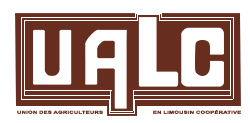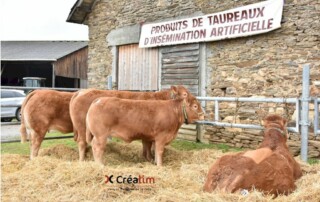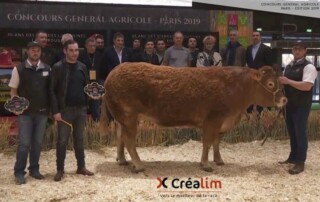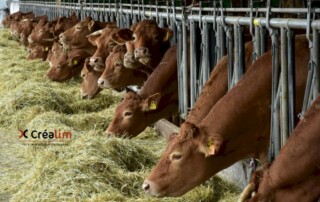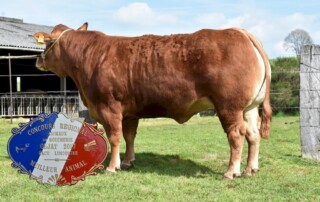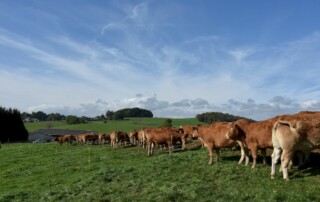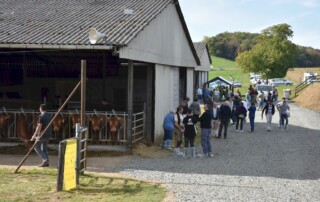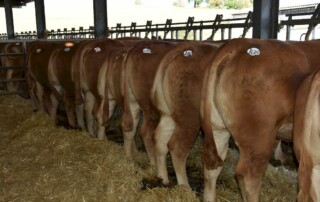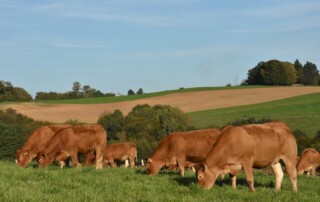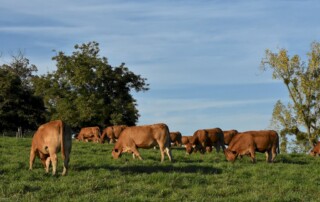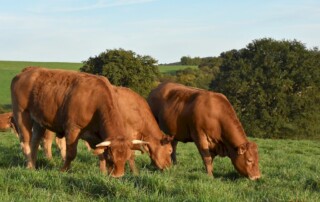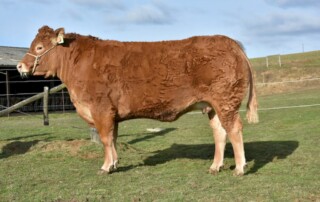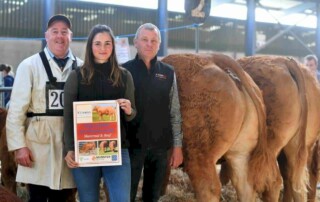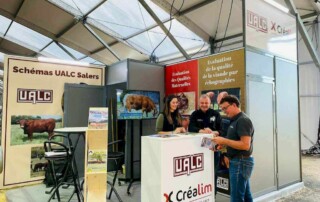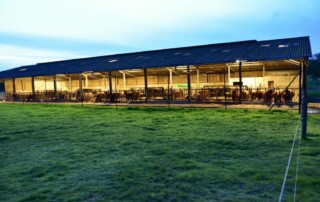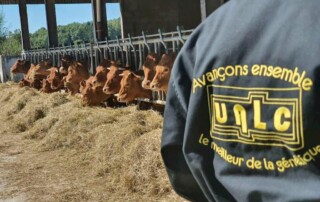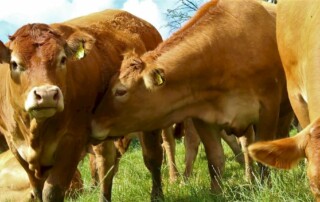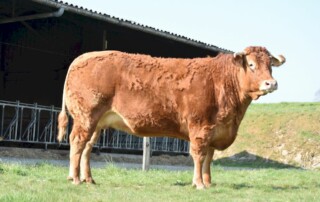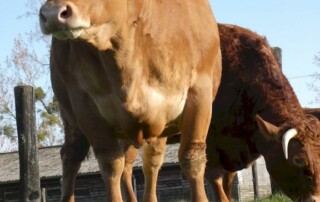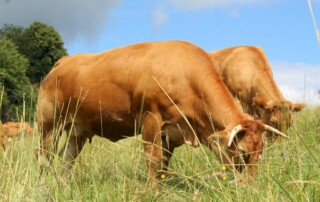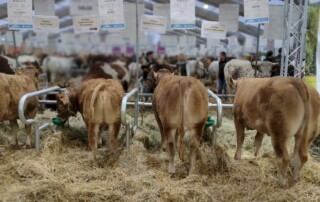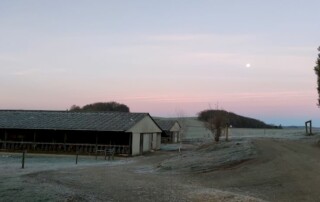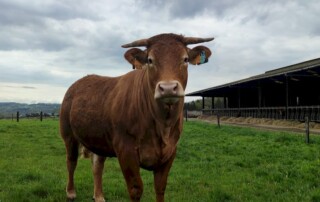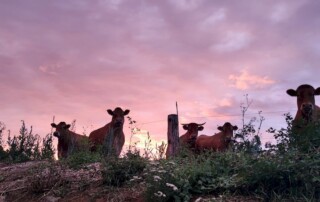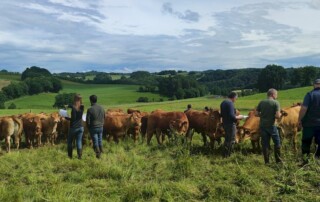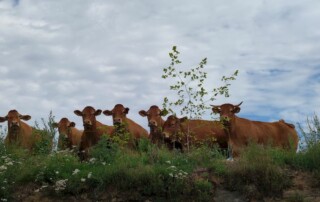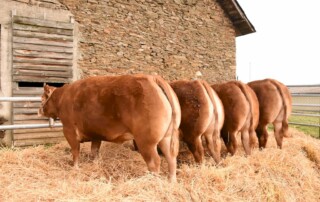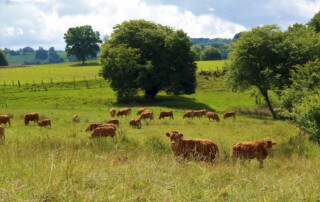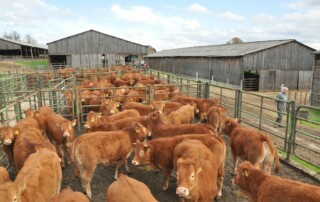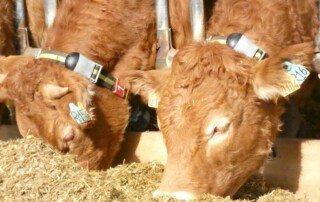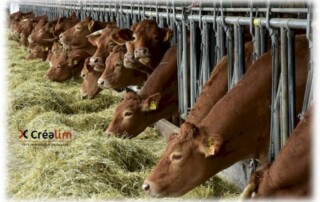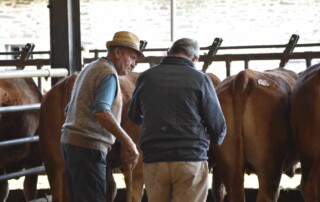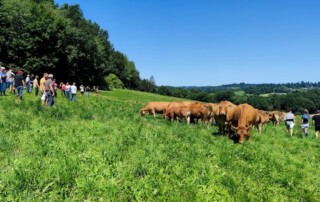A complete selection scheme for Limousin bulls by AI improvers
In the heart of the Corrèze region, the Moussours Stationhas set itself apart by maintaining an evaluation on female progeny of the Maternal Qualities of Limousin bulls offered for Animal Insemination (AI) by Créalim, prior to their distribution.
- 225ha UAA with 85% grassland (natural, temporary and alfalfa) and 15% maize
- Grass silage, wraps, hay, regain
- Corn silage
- 100% straw purchase
- 3 series in evaluation: Livestock varying over the year from 480 to 800 animals.
- 320 heifers aged 7-11 months entered
- 224 heifers for breeding between 15 and 18 months old
- 125 primiparous cows in lactation after a first calving at 24 months
- 6 employees with 4 business units: heifer rearing, rearing of primiparous heifers and their calves, feed and crops + 2 Limousin technicians to support data collection and evaluation monitoring + 1 engineer in charge of the R&D unit
EVALUATION OF MALES AT INDIVIDUAL CONTROL STATIONS (UNTIL 2023) :
In their areas, the technicians of each Créalim member cooperative carry out directed and contractual matings on bull dams on farms to create the future males of tomorrow’s Créalim AI scheme. Once the calves have been born, they return to the farms to take cartilage samples and determine the animals’ GEMBAL genomic predictors at an early age. Depending on the results and the evolution of the calves under the mothers, they agree with the breeders and the Herd-Book technicians to declare the most interesting animals to the SNQ in Lanaud. 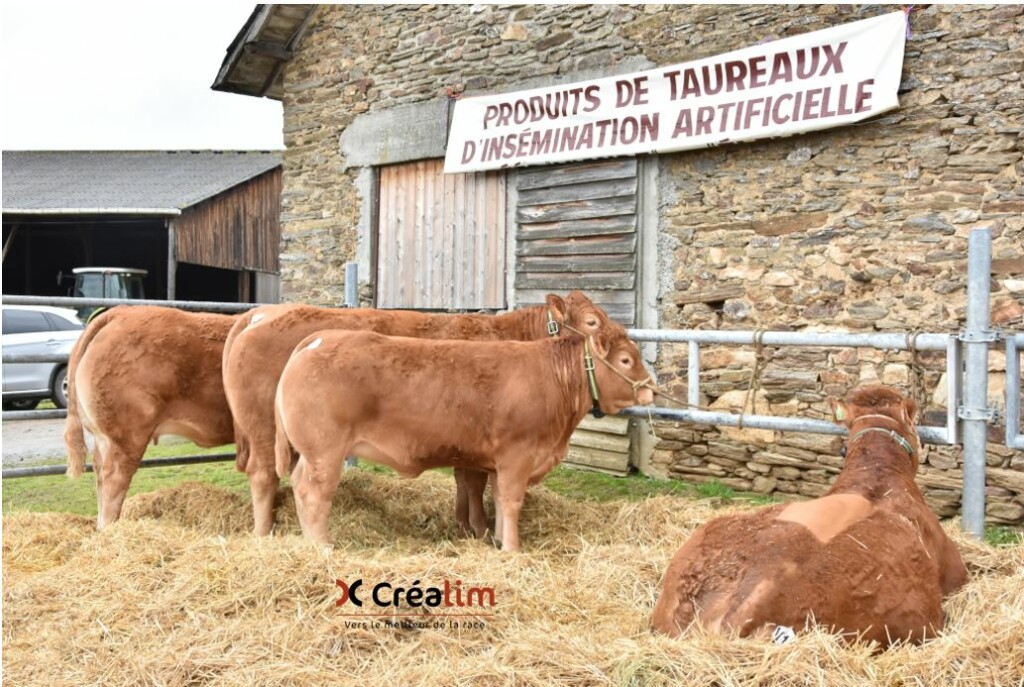 Until 2023, technicians and breeders appointed by Créalim met the week following the calves’ arrival at Lanaud, for the first 3 evaluation series only. The calves in the4th series were too young to be indexed at the Individual Control (IC) station compared with the1st batch. This selection committee was divided into two parts:
Until 2023, technicians and breeders appointed by Créalim met the week following the calves’ arrival at Lanaud, for the first 3 evaluation series only. The calves in the4th series were too young to be indexed at the Individual Control (IC) station compared with the1st batch. This selection committee was divided into two parts:
- Day 1: the technicians pre-sorted 50 to 70 calves out of the 150 to 200 brought in, based on the papers of each animal (systematic exclusion of calves <92 in IFNAIS GEMBAL and with mothers too low in production and therefore poor IVMAT), but also on the morphology of the animals present (observation of legs and hooves, pelvises, backs).
- Day 2: the breeders fine-tuned their selection according to the information on the paperwork and morphology, selecting 12 full calves and 6 alternates.
Once the choice had been made, the calves stayed an extra 15 days at the SNQ in Lanaud to await the results of docility and complementary health tests. So, 3 weeks after their arrival at Lanaud, the 12 calves finally chosen by Créalim joined the Station de Contrôle Individuel in Corrèze to begin their own performance evaluation. In 2024, Créalim has decided to do away with the CI stage, leaving the calves to be assessed at the SNQ in Lanaud, and setting up a selection committee not at the start of the controls, but at the end. This means that4th series calves can now be recruited for AI. No longer will 36 calves be evaluated on their own performance at the station, to keep 15 for AI (10 permanent + 5 substitutes), but 10 to 12 males will be purchased directly by Créalim each year.
ANIMAL HUSBANDRY IN CI (until 2023)
Following the dates of entry to the SNQ at Lanaud, the calves selected by Créalim joined the Station de Contrôle Individuel in 3 entries: the1st group arrived in July, the2nd group in September and the3rd in November. They were grouped by age in boxes of 6-7 animals maximum. On entry, they were given a foot bath, sanitary clipping, a collar connected to the DAC (Automatic Concentrate Dispenser) and weighed. First, they underwent a 5-week adaptation period to get used to feeding DAC exclusively, which was essential for measuring their feeding efficiency. The Idele/INRAE protocol defined a pelleted feed, rather poor at 0.72 UFV and 14% MAT, with unlimited access to straw to help rumination. Depending on their weight on entry, on day1 they received 1kg of feed per 100kg of live weight + 500g (i.e. 5.5kg of feed for a 500kg calf). The amount of programmed feed distributed increased by 120g/day during the adaptation period and by 150g/d during the control period. At the end of the 35-day adaptation period, the calves were weighed on two successive days to determine an average weight at the start of the controls. This was followed by monthly weighings and another double weighing at the end of the 84-day evaluation period. Due to the staggered assessments between the groups, Batch1 finished at the beginning of December and had to wait for Batch2 to finish at the beginning of January, and Batch3 at the end of February. During this waiting period, the quantity of feed distributed was gradually reduced to 7kgs per day. 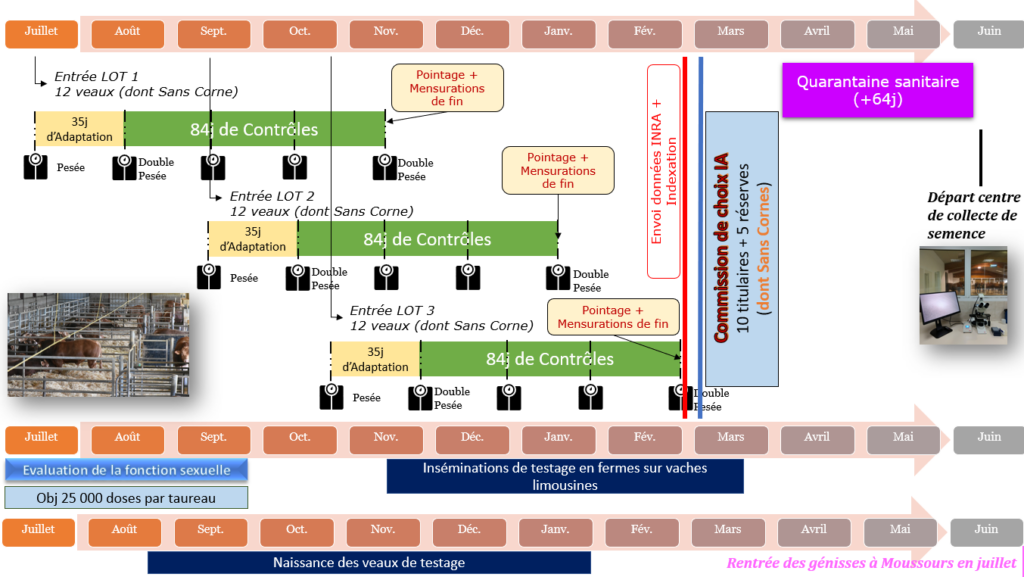
BECOMING CALVES (until 2023)
When the3rd and final CI control batch had completed its evaluation, all data were sent to GENEVAL for indexing. At the beginning of March, with the publication of indexes and the qualification of animals as “RJ” or “Espoir”, the Créalim AI selection committee met once again to select 10 full calves and 5 alternates to keep from the 36 evaluated. In the same way as the choice was made at the entrance to Lanaud, a pre-sorting was carried out by the technicians, excluding calves with crippling hoof and plumb problems or very poor performance. Breeders commissioned by Créalim refined the choice of the 15 males selected for AI. Calves with very poor hooves or aggressive behavior were slaughtered. Calves not kept for AI, but judged to have good performance and functional aptitudes, were sold at an open day at the CI Station. The event also provided an opportunity to present the 15 bulls selected by Créalim before they begin a 64-day sanitary quarantine, closed to the public. During this quarantine period, the calves were re-housed in boxes of 3 or 4 for greater comfort, and continued to be fed on the DAC with unlimited hay. Under the supervision of an accredited veterinary surgeon, numerous clinical and blood tests were carried out to ensure that the bulls were in perfect health before entering the insemination center. [Toujours le cas après 2024] At the end of this quarantine period, at the beginning of June, the bulls go to an insemination center to begin a 10-week “sexual function” period to test the quality of their fresh and thawed semen. Preferably the holders, but based on quality results, Créalim decides in September on the 10 bulls (out of 15) to be offered in the inseminators’ tanks as ‘Testing Bulls’. Test inseminations” must be carried out between 15/11 and 15/03 on Limousin cows, by all breeders interested in taking part in the evaluation of Créalim’s Limousin bulls. All females born from these “Test Inseminations” are automatically purchased by Créalim (with the exception of twins, those born on heifers, and those with health concerns such as lameness or chronic disease) to join the Moussours Station after weaning, to enable their sire to be evaluated on Maternal Qualities.
EVALUATION OF MATERNAL QUALITIES ON PROGENY AT MOUSSOURS : FEMALE MANAGEMENT
Créalim distinguishes itself from other Limousin bull breeders, especially by maintaining this in-station evaluation of maternal qualities. As these traits are known to be moderately to poorly heritable, it is all the more important to homogenize the effects of the environment by establishing a common breeding style for evaluation, in order to best express the differences in performance for all progeny. In addition, on-station evaluation enables us to carry out more precise checks on these maternal traits, such as assessing the quantity of milk produced by the mothers by weighing the calves twice, before and after suckling. In July of each year, all the heifers born from these “test AIs” return to the Moussours Station during the same week. Due to a long period of AI testing (from 15/11 to 15/03), the heifers have a wide age range: from 6.5 months for the youngest to 11 months for the oldest. On arrival, they all undergo sanitary shearing, RSPI3 influenza vaccination, deworming, cartilage sampling (to check parentage and identify genetic markers) and are fitted with a station loop with a letter and a number (the letter identifies the bull being tested, and the number ranks his daughters from oldest to youngest). Allotted by age, they will be led for breeding from 15 months of age to ensure a first calving at 24 months at the Station. They will wean their first calf at around 7.5 months of age, and will then be sold to their breeder or to other breeders interested in integrating them into their herds. From the time they enter Moussours in July, until they are put out to grass in April of the following year, the heifers are kept in buildings, in groups of 16, to control the feed they receive and aim for a minimum target of 800g/d of growth until they are put out to stud at 15 months (to reach around 450kgs liveweight at 15 months). They receive a bowl-mixed feed, varying according to the forage stocks produced on the Station: silage, hay or alfalfa for protein, corn silage for energy, straw (entirely purchased as no cereals are produced on the Station), nitrogen supplements and minerals. They are turned out to pasture in batches of 64 from April to September, with a gradual return to the calving barn 3 weeks before the expected calving date (fertilizing AI date + 284 days of gestation on average). At this time, they receive a “pre-calving” ration based on rough hay, are dewormed and fitted with a SMARTVEL calving sensor. Once calved, they are grouped by calving date in boxes of 14, avoiding an age difference between calves of more than 7 days. This avoids the “stealing calf” effect and limits contamination of the youngest calves by the oldest. The dams are fed a slightly higher energy ration to enable them to produce 8kgs of milk: corn and grass silage, hay and nitrogen corrector. As for the calves, they are not supplemented until they reach 120 days of age, as milk recording is essential for estimating the quantity of milk produced by the mother at 60 and 120 days of lactation. They are then weaned at 7.5 months of age, and raised to 320kgs for females and 350kgs for males, before being sold as grazers. Except for problems at calving, aggressive behavior, or very low milk production, the mothers are inseminated after a synchronization of heats before being sold at the annual sale in September each year. Every year, you’ll find bull production results in the new Créalim catalog, available from 01/10 at the Sommet de l’Elevage in Cournon d’Auvergne, as well as in PDF format on the Station de Moussours Facebook page and on this website.
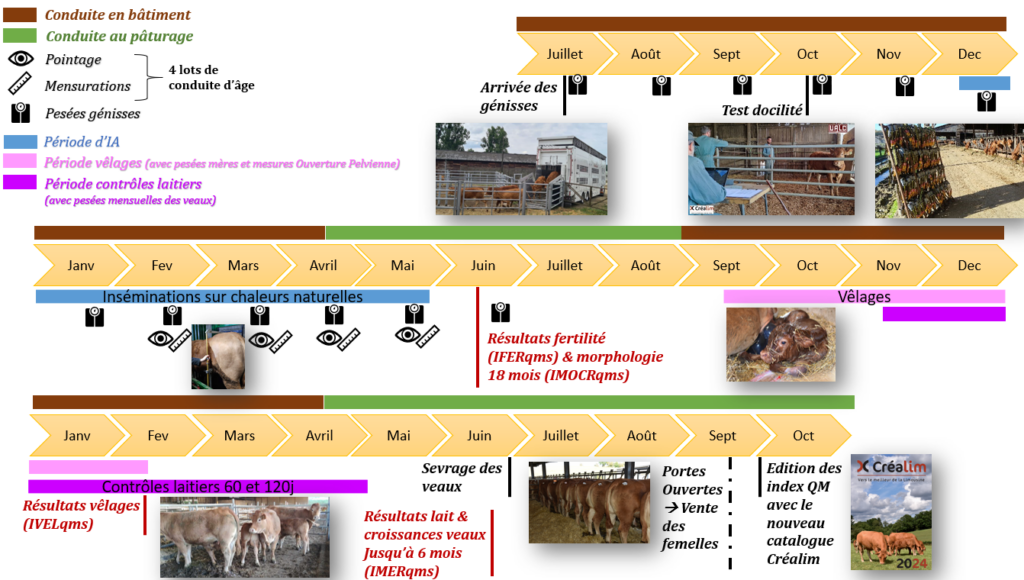
FEMALE CONTROLS AT MOUSSOURS
The Maternal Qualities indexing of the bulls distributed by Créalim includes 4 criteria, with weightings determined based on technical-economic criteria reflecting the pursuit of efficient Limousin cattle at the herd level. This summary index is constructed as follows: IQM = 20% IMOCR + 40% IFER + 15% IVEL + 25% IMERIMOCRqms(Index Morphologie Croissance): this index reflects the morphology and growth of heifers at 18 months. They are weighed every 28 days, from their arrival at the station to the weaning of their1st calf, and an 18-month PAT is calculated by intrapolation. At this standard age, body measurements are also taken (height at withers and sacrum, widths at shoulders, chest, hips, trochanters and pins, length of body and pelvis, circumference of chest, feel of tenderloin, thickness of hide), as well as a score by an Idele-approved technician (description of muscular and skeletal development, functional aptitudes, breed qualities and hooves). IFERqms (Fertility and sexual precocity index): this index expresses the percentage of pregnant heifers at the end of 74 days of inseminations on natural heat. Sexual precocity is assessed from 12 months of age by twice-daily observations and HEATIME heat collars, up to 458 days of age. Heifers not detected in heat at the end of the 10-week AI period are given an induction treatment and then inseminated. This occasional use of induction treatment ensures a sufficient number of calving daughters per bull, but will not mask the bull’s loss of fertility. Calf viability is also included in this IFERqms index. IVELqms (Calving Aptitude Index at 24 months): the heifer’s calving preparation and pelvic opening measurement are taken into account (a method identical to that used on their fathers, under anaesthesia and in this case 48 hours after calving, and recorded in the OPqms index), enriched with the calf’s birth weight and birth conditions, and the dam’s post-calving weight.
Other data are recorded but do not give rise to specific indexing: calf presentation, maternal instinct, calf vigor, delivery, udder morphology. IMERqms (Index Aptitude à l’allaitement): this index reflects the mother’s ability to produce a heavy calf at weaning. The PLAITqms index, a component of IMERqms, is calculated from milk tests carried out at 60 and 120 days of lactation. Calves are separated from their mothers the day before these checks and weighed before and after morning and evening feedings. Calves are weighed every 28 days from birth to weaning at 7.5 months. At this point, the Muscular Development (MD) of the mother-calf pair is measured by an approved technician. The IMERqms index therefore combines 15% of PLAITqms, 80% of calf weight at 120 days and 5% of the calf’s DM score. Behavior: although not indexed, a docility test is carried out on all heifers in October of each year. The aim is to differentiate between skittish and aggressive heifers. If more than 1 in 2 of a bull’s heifers is found to be dangerous, this criterion can be a reason for eliminating the bull. This evaluation differs from that carried out on farms by HBL and Bovins Croissance technicians (REACsev, reactivity at weighing scale entry and COMPsev, behavior at weaning time). The1st step consists in sorting the designated heifer (e.g. A16) from its group of 8, isolating it on a concrete area and observing its behavior alone (motionless, walking, running, fleeing, charging), then in the presence of a motionless operator in the center of the pen. The test is completed by trying to isolate the heifer in a dark corner and holding her still for 30 seconds before being allowed to stroke her, or not.
